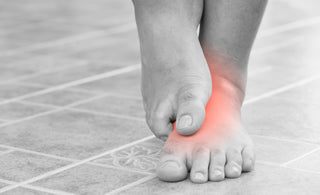
Neuropathy in the feet, also known as peripheral neuropathy, is a common yet often underestimated health issue. It occurs when the peripheral nerves, those outside the brain and spinal cord, are damaged. Because the nerves in the legs and feet are the longest in the body, they are more vulnerable to injury and metabolic stress.
For people with diabetes, neuropathy in the feet is one of the most frequent and serious complications. It not only causes discomfort but also increases the risk of ulcers, infections, and, in advanced cases, amputations. Understanding the causes, what makes neuropathy worse, and what treatment options are available, including simple tools such as diabetic socks, is critical to preventing long-term complications.
What Causes Peripheral Neuropathy in the Feet?
Peripheral neuropathy can have many causes, but diabetes remains the most significant worldwide. Chronic high blood sugar gradually damages blood vessels and nerves, disrupting communication between the feet and the brain. Over time, this reduces the ability to feel pain, temperature, or pressure, leaving the feet vulnerable.
Other causes include:
- Nutritional deficiencies: Deficiencies in vitamins, particularly B12, B1, and B6, are strongly associated with nerve damage. Vitamin B12 deficiency is common in older adults and in people who use long-term medications likemetformin or proton pump inhibitors.
- Chronic illnesses: Kidney disease, liver disease, and thyroid disorders alter the body’s metabolism and can harm nerves.
- Toxins and medications: Prolonged alcohol use, heavy metals, and certain chemotherapy drugs are known to damage nerves.
- Infections and autoimmune diseases: Viral infections such as HIV or hepatitis C, and autoimmune conditions like lupus or rheumatoid arthritis, can cause inflammation that injures nerves.
- Inherited conditions: Some people are born with genetic neuropathies such as Charcot-Marie-Tooth disease.
- Physical injury: Trauma, repetitive stress, or poor footwear can compress nerves or cause long-term irritation.
In roughly one-third of cases, no specific cause is found. These are called idiopathic neuropathies, and they remain an active area of research.
What Aggravates Neuropathy in the Feet?
Once neuropathy develops, certain factors can worsen symptoms or speed up progression. Recognizing these aggravating factors is important because many can be modified through lifestyle changes or medical care.
- Poor blood sugar control: For diabetic patients, this is the most critical factor. Fluctuations and persistent high glucose cause ongoing nerve damage.
- Smoking: Nicotine constricts blood vessels, reducing circulation in already vulnerable feet.
- Alcohol use: Alcohol directly damages nerves and also interferes with the absorption of B vitamins needed for nerve health.
- Vitamin deficiencies: Low B12, often overlooked, can intensify neuropathy.
- Poor footwear: Shoes that are too tight, socks with harsh seams, or prolonged standing in unsupportive footwear can create friction and pressure points.
- Reduced circulation: Peripheral artery disease or immobility limits oxygen and nutrient delivery to nerves.
- Temperature extremes: People with neuropathy may not feel hot or cold properly, making them more likely to burn or freeze their feet without realizing it.
Even something as simple as walking barefoot at home can aggravate the condition, since unnoticed cuts or blisters can quickly become infected.
Symptoms of Neuropathy in the Feet
The symptoms vary depending on the type and severity of nerve damage, but they often progress gradually.
- Sensory symptoms: Tingling, burning, numbness, or sharp, electric-like pain. Some people describe it as “walking on pins and needles.”
- Motor symptoms: Weakness in the foot muscles, difficulty lifting the front of the foot (foot drop), or poor coordination.
- Autonomic symptoms: Changes in sweating, skin dryness, or altered temperature control in the feet.
Because neuropathy often reduces sensation, injuries may go unnoticed. This makes routine foot checks critical, especially for diabetic patients.
Best Treatments for Diabetic Neuropathy in the Feet
There is no single cure for diabetic neuropathy, but treatment can greatly slow its progression, relieve pain, and reduce complications. A combination of medical care, lifestyle changes, and protective measures works best.
Blood Sugar Control
Keeping blood sugar within the target range is the most effective way to protect nerves from further damage. This often includes:
- Monitoring glucose regularly.
- Following a balanced diet with low refined sugar and high fiber.
- Using prescribed diabetes medications or insulin consistently.
Medications for Symptom Relief
Neuropathic pain is often resistant to standard painkillers. Instead, doctors may prescribe:
- Anticonvulsants such as gabapentin or pregabalin.
- Antidepressants like duloxetine or amitriptyline alter pain signaling in the nervous system.
- Topical treatments such as lidocaine patches or capsaicin creams for localized burning or tingling.
These treatments help with pain management but do not cure the underlying nerve damage.
Lifestyle and Physical Therapy
Exercise improves blood circulation, helps regulate blood sugar, and strengthens muscles to reduce fall risk. Activities like walking, swimming, or cycling are recommended. A diet rich in antioxidants and vitamins supports nerve repair.
Physical therapy may include balance exercises, strength training, and stretching to maintain mobility.
Preventing Complications
Foot care is a cornerstone of neuropathy management. Patients are encouraged to:
- Inspect feet daily for cuts, blisters, or color changes.
- Keep skin moisturized, but avoid applying lotion between toes, where excess moisture can lead to fungal growth.
- Trim nails carefully to prevent ingrown toenails.
- Visit a podiatrist regularly for professional care.
The Role of Diabetic Socks
One often-overlooked tool in managing neuropathy is the use of diabetic socks. While they do not reverse nerve damage, they provide vital protection against complications that can lead to ulcers or infections.
Key Features of Diabetic Socks
- Seamless design: Prevents friction and blisters that may go unnoticed due to reduced sensation.
- Moisture-wicking fabric: Keeps feet dry, lowering the risk of fungal and bacterial infections.
- Non-binding tops: Avoids constricting circulation, unlike regular socks with tight elastic.
- Cushioning: Extra padding under the heel and ball of the foot reduces pressure points.
- Antimicrobial fibers: Some socks are infused with silver, copper, or bamboo to fight odor and bacteria.
Why They Matter
Research has shown that padded non-binding diabetic socks can reduce plantar pressure and protect vulnerable skin. For someone with neuropathy who may not feel a blister forming, this simple protection can prevent infections that could otherwise escalate into ulcers.
Wearing diabetic socks daily, along with proper shoes, is an inexpensive but powerful step in preventing complications.
Long-Term Outlook and Prevention
The outlook for neuropathy depends largely on how early it is detected and how well it is managed. When blood sugar is tightly controlled and when patients follow a comprehensive care plan, progression can be slowed and complications minimized.
Preventive strategies include:
- Regular medical check-ups to adjust treatment as needed.
- Annual foot exams, or more frequent if ulcers or injuries are present.
- Avoiding smoking and alcohol, which are both toxic to nerves and blood vessels.
- Using protective socks and footwear every day, even at home.
Conclusion
Neuropathy in the feet is a serious complication, particularly for people with diabetes. It is caused by a variety of factors, including high blood sugar, nutritional deficiencies, chronic illnesses, and toxins. Once present, it can be aggravated by smoking, alcohol, poor footwear, and lack of circulation.
Treatment requires a multifaceted approach: controlling blood sugar, adopting a healthy lifestyle, using medications for pain, and practicing vigilant foot care. Among the simplest but most effective tools are diabetic socks, which reduce friction, wick away moisture, and help prevent ulcers.
By combining medical treatments with protective habits, individuals with neuropathy can maintain mobility, reduce discomfort, and significantly lower their risk of serious complications.
